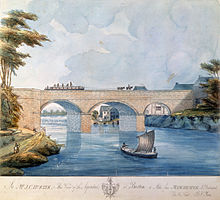Barton Aqueduct


The Barton Aqueduct, opened on 17 July 1761, carried the
Construction proceeded quickly, but disaster almost struck when the aqueduct was first filled with water and one of its three arches began to buckle under the weight. Remedial work took several months, but the aqueduct was still opened to traffic only 15 months after the enabling
Background
The original intention was for the
Although a gifted engineer Brindley had no formal education and rarely, if ever, committed his designs to paper.
Although the duke had seen navigable aqueducts in use on canals when travelling abroad on his
Construction

At about 200 yards (180 m) long, 12 yards (11 m) wide and 39 feet (12 m) above the river at its highest point, the aqueduct was, for its time, an enormous construction.
On the day it was first tested the water was allowed to flow in, but one of the arches began to buckle under the weight. Brindley, overcome with anxiety, retired to his bed at the Bishop Blaize tavern in nearby
Operation and legacy
The aqueduct was opened to traffic on 17 July 1761, only 15 months after the enabling Act had been passed,
Although the aqueduct was 12 yards (11 m) wide overall, the waterway it carried was only half that width. The Bridgewater Canal had been built to accommodate the Mersey flat boats then in common use, which had a beam of about 14 feet (4.3 m), making two-way traffic impossible. A signalling system was therefore installed to control access to the aqueduct. A pole 15 feet (4.6 m) high in the centre of the arch at the Stretford bank supported a semaphore system with two arms on each side, operated by levers at ground level.[10]
Although Gilbert later had to resurface the aqueduct, the structure remained in use for more than 100 years.[16] In the first volume of his Lives of the Engineers (1862) Scottish author Samuel Smiles said of the construction that "Humble though it now appears, it was parent of the magnificent aqueducts of Rennie and Telford, and the viaducts of Stephenson and Brunel".[17]
Replacement
Barton Aqueduct's fate was sealed with the passage of the
Some of the stonework of Brindley's aqueduct has been preserved in the nearby Barton Memorial Arch, a monument to his "castle in the air".[19]
References
Citations
- ^ Atkinson (2002), p. 14
- ^ Nevell (1997), p. 135
- ^ a b c Atkinson (2002), pp. 14–15
- ^ Weale (1844), p. 45
- ^ a b Weale (1844), p. 47
- ^ Bode (2008), pp. 21–24
- ^ Atkinson (2002), p. 15
- ^ a b Bode (2008), p. 22
- ^ a b Atkinson (2002), p. 20
- ^ a b c Atkinson (2002), p. 21
- ^ Malet (1977), p. 65
- ^ Ruddock (2008), p. 125
- ^ Ruddock (2008), pp. 125–131
- ^ Malet (1977), pp. 65–66
- ^ Weale (1844), p. 11
- ^ Malet (1977), p. 66
- ^ Smiles (1904), pp. 212–213
- ^ Atkinson (2002), pp. 36–37
- ^ Atkinson (2002), p. 37
Bibliography
- Atkinson, Glen (2002), Barton's Bridges, Neil Richardson, ISBN 978-1-85216-146-0
- Bode, Harold (2008), James Brindley: An Illustrated Life of James Brindley, 1716–1772, Shire, ISBN 978-0-85263-485-1
- Nevell, Mike (1997), The Archaeology of Trafford, Trafford Metropolitan Borough with University of Manchester Archaeological Unit, ISBN 978-1-870695-25-1
- Malet, Hugh (1977), Bridgewater: The Canal Duke, 1736–1803, Manchester University Press, ISBN 978-0-7190-0679-1
- Ruddock, Ted (2008), Arch Bridges and their Builders 1735–1835, Cambridge University Press, ISBN 978-0-521-09021-6
- OCLC 44962634
- Weale, John, ed. (1844), "Memoir of James Brindley", Quarterly Papers on Engineering, Volume 1, George Woodfall and Son
